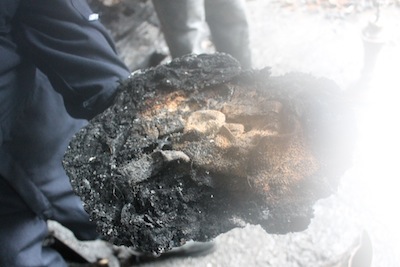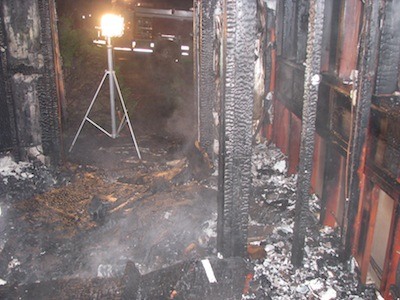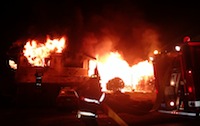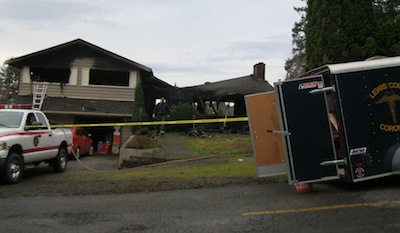 [1]
[1]Investigators collect bundle of partially burned restaurant towels from Ham Hill Road house fire. / Courtesy photo from Centralia Police Department
By Sharyn L. Decker
Lewis County Sirens news reporter
CENTRALIA – Most people have heard of the dangers of “spontaneous combustion” from oily rags left laying around the garage or workbench.
But how many are aware of the risks associated with a hand towel or dish cloth, for example, used with products one would find in their kitchen cupboards?
Not even Centralia police detective Dave Clary who is trained in fire investigations had come across such a scenario before.
The house fire on Ham Hill Road that took the lives of three children is now labeled with a cause of undetermined. But after two months of investigating, with numerous interviews and examinations that filled more than 50 pages of reports, the experts came up with one possible cause and one probable cause, according to Clary.
It’s possible a compact florescent light bulb in a lamp could have malfunctioned and ignited the fire. Clary knows that because a private investigator hired by the insurance company asked if such bulbs were used in the home and noted they have been known to do that.
He told Clary if he had the bulb, he might be able to tell if it went bad by looking at it. But the fire in that area was so intense that no remains of a bulb were located.
The probable cause of the fire, according to Clary, because its more than 50 percent likely to be the reason it occurred, was from recently laundered oily towels placed in a milk crate near the front door.
Clary, who was the lead police investigator for the fire, said he was previously unaware CFL bulbs could be risky or dangerous.
“But, by the same token, I didn’t know vegetable oil was unstable,” he said.
The recently released reports and photos from the nighttime blaze offer information on previously unanswered questions, detail heroic attempts by police officers and firefighters to rescue the children and shed light on what their mother Sue Tower underwent before eventually standing outside the burning home in what police officers described as in a daze, or in shock.
It was an ordinary week night, a Thursday, and the family shared a dinner of pot roast, potatoes and sourdough bread Tower baked from scratch.
The 40-year-old single mother put her children to bed, reading a story to her youngest, Samuel, and said she closed their bedroom doors after tucking them in. Madeline had been having nightmares, so she slept with her older brother Benjamin that night.
The four had moved in to the rental home the previous April; their father lives in Thurston County.
The children’s bedrooms were on the upper floor of the split level home, with the main living area on the middle level and Tower’s bedroom on the ground floor at the back of the garage.
From her bed, Tower could see up the stairs into the kitchen and said she awoke to a noise like a crack, saw a glow near the stove and saw smoke.
She ran up the stairs twice, the first time in her underwear, the second time after pulling on jeans and a sweatshirt, but was turned back by the intense heat. She grabbed her phone and called 911, and ran out the back door of her bedroom hoping to get in through the back door on the main floor, but realized it was locked and she didn’t have her keys.
Detective Clary’s description of the 911 call characterizes Tower as panicked, out of breath, seemingly terrified and finally not able to speak coherently. She tells the dispatcher there is a fire in her kitchen.
Tower runs back through the house and opens the garage door, thinking that would help get rid of the smoke. A dispatcher tells her that was not the best thing to do.
“Over and over again she tells the dispatcher that she has children in the home,” Clary writes. “She advises that she is in the house downstairs and her children are upstairs and she cannot get to them.”
She goes outside and sees the entire house is on fire.
And she begins to scream.
Benjamin D. Tower, 12; Madeline R. Tower, 10; and Samuel J. Tower, 7, never made it out of their bedrooms, according to the Lewis County coroner. Coroner Warren McLeod said asphyxiation from smoke and carbon monoxide blocked their breathing and it’s more likely than not they did not suffer.
The bedroom door to one of their rooms was found open.
The owner Bill Bates, a former Centralia city council member, told detectives there were smoke detectors throughout the wood-framed house.
Sue Tower said she didn’t hear a smoke alarm. The one on the main floor had recently begun chirping, so she took the battery out and set it on the counter as a reminder to buy a replacement, she told police. She said she hadn’t checked other detectors.
A carbon monoxide detector was plugged in to one of the outlets on the main floor.
The fire was investigated by Riverside Fire Authority Assistant Chief Rick Mack, four fire department investigators, four detectives with the Centralia Police Department and two private investigators hired by Bates’ insurance company.
The reports and photos outline numerous visits to the scene, close examination of several appliances and electrical outlets and the sifting through the debris to collect various items as possible evidence.
The house was heated with an electric forced-air furnace.
The worst fire damage was on the main floor, not in the kitchen but in the living room.
Tower pondered possible causes with authorities, noting an electrical breaker would trip when the microwave was used and that one of the control knobs on the stove sometimes stuck making it difficult to shut off. She mentioned some of the electrical outlets were “loose.”
She was certain she hadn’t been burning any candles, even though she liked them and used them.
The reports reflect that police detectives were also taking note, looking for any suspicious behavior on the mother’s part.
Early on, investigators narrowed the origin of the fire down to an area near the front door, based on burn patterns they observed.
A piece of carpet and pad from the spot was collected to be tested for ignitable liquids.
It wasn’t until almost a week after the fire as detective Clary was contemplating the possible ignition sources that he recalled cloth items they had found and remembered Tower worked at a restaurant where cooking oil would be used.
She told the investigators she had washed a batch of soiled towels that afternoon and after drying them immediately placed them in black plastic milk crate by front door, so she would remember to bring them back to work the next day.
Tower said they use a lot of rice bran oil at Hub City Grub.
The remains of the towels – which Clary said still smelled somewhat of used cooking oil – along with samples of the cooking oil the restaurant uses and towels that didn’t go through the fire were collected for testing.
The results from the lab came back noting the fats detected would have a low to moderate tendency toward “self heating.”
However, if laundering doesn’t remove all the oils, the cloth would be subject to spontaneous ignition with the additional of heat from drying, when poor dissipation of the heat occurs, the report indicated.
Instances like this have occurred all over the country and cases have even been documented in Centralia, according to the reports.
Something similar happened last summer at a Chehalis night spot [3], where firefighters responded to a smell that was not quite right just before closing, and eventually found a slightly smoking stack of towels. They had been used to clean up and then washed and dried before being put away, but when an investigator took them outside, he found heavy charring in the center.
Oily rags, dirty or clean, should be stored in something metal with a lid on it, the Chehalis fire investigator said at the time.
Detective Clary found the scenario is what more likely than not led to the deadly fire on the 900 block of Ham Hill Road in Centralia on March 4.
“When Suzanne washed and dried the towels she brought home from the restaurant and then stuffed them into the milk crate, she inadvertently combined the necessary ingredients for the towels to self heat and ultimately break into flame,” Clary writes.
Both detective Clary, Assistant Fire Chief Mack and the insurance investigator agreed they could rule out all the potential causes except for the towels, and except for a bad CFL bulb – since they never found the bulb.
Because more than one possible cause exists, the cause of the fire is officially ruled undetermined. It is also ruled to be accidental.
Sue Tower was stunned after the meeting with investigators, when they explained what they knew.
“It’s a really hard thing to process,” she said. “It’s such a fluke, I don’t even normally bring them home.”
Tower continues on, still not able to plan more than one, maybe two, days in advance.
Every night, she relives the nightmare, she said.
“Sometimes I’m smarter, quicker, I do something different,” she said. “I’m not going to pretend I’m even remotely okay.”
She calls towels with oil residue festering little bombs. Even just vegetable oil, she said.
The former Chehalis native said she began researching and found quite a bit of information, noting television journalist Diane Sawyer did an episode once on the dangers of linseed oil.
“I had no idea, and there are so many people who don’t know,” Tower said.
•••
For background, read “Heavy hearts as family loses three in Centralia house fire” from Friday March 4, 2016, here [4]
•
 [5]
[5]Investigators took numerous photos at the Ham Hill Road house for their fire investigation, many of them just inside the front door. / Courtesy photo from Centralia Police Department
•

